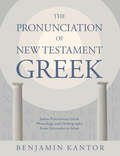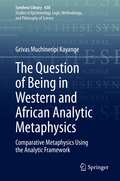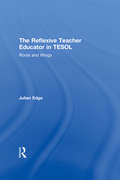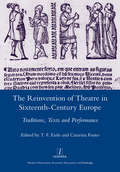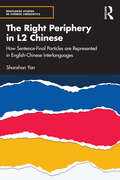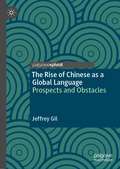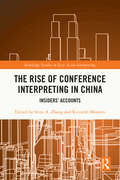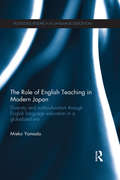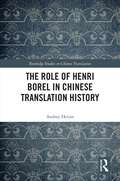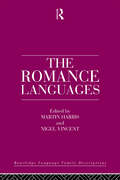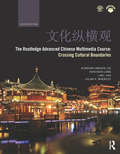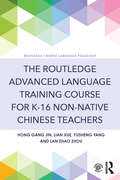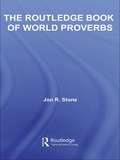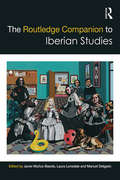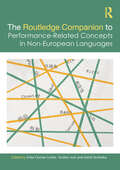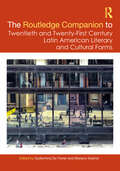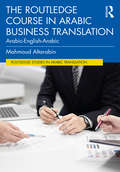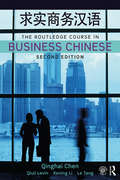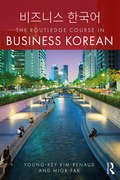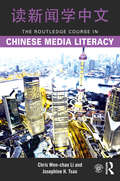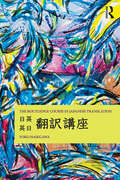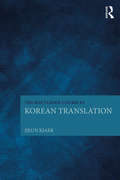- Table View
- List View
The Pronunciation of New Testament Greek: Judeo-Palestinian Greek Phonology and Orthography from Alexander to Islam (Eerdmans Language Resources)
by Benjamin KantorWhat did the apostles&’ Greek sound like?How would New Testament Greek have been pronounced? Often students are taught Erasmian pronunciation, which does not even reproduce Erasmus&’s own pronunciation faithfully, let alone that of the New Testament authors. In his new book, Benjamin Kantor breaks a path toward an authentic pronunciation of Koine Greek at the time of the New Testament.The first comprehensive phonological and orthographic study of Judeo-Palestinian Koine Greek, The Pronunciation of New Testament Greek surveys thousands of inscriptions and papyri to determine its historical pronunciation. Benjamin Kantor covers his cutting-edge methodology, the chosen sources, and their context before explaining the pronunciation of each Greek phoneme individually. Written for interested students and specialists alike, this guide includes both explicatory footnotes for novices and technical analysis for veterans.
The Question of Being in Western and African Analytic Metaphysics: Comparative Metaphysics Using the Analytic Framework (Synthese Library #438)
by Grivas Muchineripi KayangeThe main aim of this book is to discuss fundamental developments on the question of being in Western and African philosophy using analytic metaphysics as a framework. It starts with the two orthodox responses to the question of being, namely, the subject-verb-object language view and the rheomodic language view. In the first view, being is conceived through the analysis of language structure, where it is represented by subjects (particulars), objects, and relations (often universals). In the second view, there are different variations; however, the common idea is that the world's structure is revealed in the root verb of terms. This suggests a holistic and dynamic conception of being, where everything is in a continuous process of action. The book builds on analytic philosophy and explores metaphysical concepts such as space-time, modality, causation, indeterminism versus determinism, and mind and body. The book shows that in both Western and African thought, (i) similarities in different studies confirm that philosophy is a universal activity, (ii) differences within a context and beyond confirm the perspectival nature of human knowledge as individuals attempt to interpret reality, and (iii) language influences the conceptualization of being in a particular area. One of the novel aspects is the development of visual and mathematical African models of space and time.
The Reflexive Teacher Educator in TESOL: Roots and Wings
by Julian EdgeIn this book Julian Edge explores the construct of reflexivity in teacher education, differentiating it from, while locating it in, reflective practice. Reflexivity is the key concept underpinning a view of teacher education that binds together the orientations of action research and personal development in a way that establishes common ground, common purpose, and common experience between teachers and teacher educators. Augmenting the field in important ways, The Reflexive Teacher Educator in TESOL: develops the concept of praxis as it resolves the usual theory/practice dichotomy of teacher education introduces a framework (Copying, Applying, Theorising, Reflecting, Acting) that allows present and prospective teacher educators to become reflexive individuals uses a narrative, autobiographical voice that explicates the concepts involved, while also offering practical methodological procedures for teacher education. Written with clarity and style, scholarly yet personal, dealing with reflexivity in an accessible yet non-trivial way, this book – a first in the field, distinctive in terms of what the story is and how it is told – is a gift to the profession of TESOL teacher education.
The Reinvention of Theatre in Sixteenth-century Europe: Traditions, Texts and Performance
by T.F. EarleThe sixteenth century was an exciting period in the history of European theatre. In the Iberian Peninsula, Italy, France, Germany and England, writers and actors experimented with new dramatic techniques and found new publics. They prepared the way for the better-known dramatists of the next century but produced much work which is valuable in its own right, in Latin and in their own vernaculars. The popular theatre of the Middle Ages gave endless material for reinvention by playwrights, and the legacy of the ancient world became a spur to creativity, in tragedy and comedy. As soon as readers and audiences had taken in the new plays, they were changed again, taking new forms as the first experiments were themselves modified and reinvented. Writers constantly adapted the texts of plays to meet new requirements. These and other issues are explored by a group of international experts from a comparative perspective, giving particular emphasis to one of the great European comic dramatists, the Portuguese Gil Vicente. Tom Earle is King John II Professor of Portuguese at Oxford. Catarina Fouto is a Lecturer in Portuguese at King's College London.
The Right Periphery in L2 Chinese: How Sentence-Final Particles are Represented in English-Chinese Interlanguages (Routledge Studies in Chinese Linguistics)
by Shanshan YanThe Right Periphery in L2 Chinese is among the first books to try to incorporate both advanced linguistic and acquisition perspectives to show how eight sentence-final particles are represented in English-speaking learners’ L2 Chinese. This book will inform researchers of the general construction of the right periphery in L2 grammars. Drawing on up-to-date theoretical frameworks and findings from advanced empirical studies, it sketches the general picture of the periphery that these particles occupy in English-Chinese interlanguages. Readers will grasp the problems and difficulties, and particularly the ambiguities, which learners of Chinese must grapple with in the process of acquiring sentence-final particles. Possible influential factors underlying the acquisition process are explicitly discussed as well. Researchers will also find insights in the advanced methodologies and statistics that are used to study Chinese. The book will be illuminating for researchers interested in SLA, linguists of generative theories, and educators teaching Chinese as a second/foreign language.
The Rise of Chinese as a Global Language: Prospects and Obstacles
by Jeffrey GilThis book investigates the macroacquisition of Chinese – its large-scale acquisition and adoption for various purposes by individuals, governments and organisations – and the implications of this process for the future of English as a global language. The author contextualises the macroacquisition of Chinese within the global ecology of languages, then analyses the factors responsible for the macroacquisition of Chinese, showing, in contrast to most academic and popular commentary, that a character-based writing system will not stop Chinese from becoming a global language. He then articulates three possible future scenarios: English remaining a dominant global language, English and Chinese both being global languages, and Chinese becoming a global language instead of English. The book concludes by outlining directions for further research on the acquisition and use of Chinese around the world. It will be of interest to students and scholars with an interest in English as a global language, Chinese as a second/foreign language, language education policy, and applied linguistics more generally.
The Rise of Conference Interpreting in China: Insiders' Accounts (Routledge Studies in East Asian Interpreting)
by Riccardo Moratto Irene A. ZhangIn this landmark project, Professor Zhang and Professor Moratto piece together the history of how conference interpreting developed as a profession in China after the reform and opening up of the late 1970s. Based on interviews with the alumni of the early efforts to develop conference interpreting capabilities between Chinese and English (and French), the authors illuminate the international programs and relationships which were instrumental in bringing this about. While paying tribute to the earliest interpreters who interpreted for the first-generation CPC leaders including Mao Zedong, Zhou Enlai, and Deng Xiaoping, they track key cooperative projects between Chinese ministries and both the United Nations and European Union, as well as China’s domestic efforts, which developed into today’s formal programs at major universities. An essential resource for scholars and students of conference interpreting in China, alongside its sister volume Conference Interpreting in China: Practice, Training and Research.
The Role of English Teaching in Modern Japan: Diversity and multiculturalism through English language education in a globalized era (Routledge Research in Language Education)
by Mieko YamadaThe Role of English Teaching in Modern Japan examines the complex nature of Japan’s promotion of English as a Foreign Language (EFL). In globalized societies where people with different native languages communicate through English, multicultural and multilinguistic interactions are widely created. This book takes the opportunity to look at Japan and examines how these multiple realities have affected its English language teaching within the domestic context. The myth of Japan’s racial and ethnic homogeneity may hinder many Japanese in recognizing realities of its own minority groups such as Ainu, Zainichi Koreans, and Brazilian Japanese, who are in the same EFL classrooms. Acknowledging a variety of English uses and users in Japan, this book emphasizes the influence of Japan’s recent domestic diversity on its EFL curriculum and urges that such changes should be addressed. It suggests new directions for incorporating multicultural perspectives in order to develop English language education in Japan and other Asian contexts where English is often taught as a foreign language. Chapters include: Social, cultural, and political background of Japan’s EFL education Race, ethnicity, and multiculturalism Representations of diversity in Japanese EFL Textbooks Perceptions of English learning and diversity in Japan The role of EFL education in multicultural Japan
The Role of Henri Borel in Chinese Translation History (Routledge Studies in Chinese Translation)
by Audrey HeijnsAgainst the historical background of Chinese translation in the West and the emergence of several prominent European translators of China, this book examines the role of a translator in terms of cross-cultural communication, the image of the foreign culture in the minds of the target audience, and the influence of their translations on the target culture. With the focus on the career and output of the Dutch translator Henri Borel (1869–1933), this study investigates different aspects of the role of translator. The investigation is carried out by analysing texts and probing the achievements and contributions of the translator, underpinned by documents from the National Archives and the Literature Museum in the Hague, the Netherlands. Based on the findings derived from this study, advice is offered to those now involved in the promotion and translation of Chinese culture and literature. It will make an important contribution to the burgeoning history of Chinese translation. This book will be of interest to anyone with an interest or background in the translation history of China, the history of sinology in the West, and the role of translators.
The Romance Languages: Volume 1, Structures (Routledge Language Family Series)
by Nigel Vincent Martin HarrisAvailable again, this book discusses nine Romance languages in context of their common Latin origins and then in individual studies. The final chapter is devoted to Romance-based Creole languages; a genuine innovation in a work of this kind.
The Routledge Advanced Chinese Multimedia Course: Crossing Cultural Boundaries
by Carolyn Lee Hsin-Hsin Liang Liwei Jiao Julian WheatleyThe Routledge Advanced Chinese Multimedia Course: Crossing Cultural Boundaries is an innovative multimedia course for advanced students of Chinese. Written by a team of highly experienced instructors, the book offers advanced learners the opportunity to consolidate their knowledge of Chinese through a wide range of activities designed to build up both excellent language skills and cultural literacy.? Divided into four thematic units covering popular culture, social change, cultural traditions, and politics and history, with each unit presenting three individual lessons, the volume provides students with a structured course which efficiently supports the transition from an intermediate to an advanced level. The many different texts featured throughout the lessons present interesting and accurate information about contemporary China and introduce students to useful vocabulary, speech patterns, and idiosyncratic language usage. Key features include Lively and detailed discussions of grammatical points and sentence patterns Engaging exercises for developing grammatical concepts and insight into the character writing system Systematic review of earlier material to ensure consolidation of learning Coverage of diverse and culturally relevant topics such as online dating, changing views of marriage, food culture, Confucianism? and democracy in China. Extensive cultural and historical notes providing background to the subjects presented Complementary CDs to enhance listening skills. Free companion website (http://duke.edu/web/chinesesoc/) offering a wealth of video content forming the basis of many of the listening activities linked to topics within the book. Extensively revised and updated throughout, this new edition includes new material and activities on synonyms and substantial improvements to the "composition", "Focus on characters" and "Language practicum" sections. The improved Instructor’s Resource Manual, which includes activity tips, additional exercises, answer keys and the traditional character texts, is available at http://www.routledge.com/books/details/9780415841337/
The Routledge Advanced Language Training Course for K-16 Non-native Chinese Teachers (Routledge Chinese Language Pedagogy)
by Hong Gang Jin Lian Xue Yusheng Yang Lan Zhao ZhouThe Routledge Advanced Language Training Course for K-16 Non-native Chinese Teachers is a content-based and thematically organized textbook designed for non-native in- and pre-service K-16 Chinese language teachers. Based on five years of field testing, the book offers an innovative approach to advanced language instruction, allowing users to further advance their language proficiency while continuing their professional development in teaching Chinese as a second or foreign language. The textbook: covers a range of up-to-date pedagogical and cultural themes provides a variety of engaging activities and exercises, allowing readers for K-16 to explore pedagogical and cultural issues in the target language with best classroom practices in mind familiarises users with authentic forms of modern communication in today’s China to better engage learners is accompanied by a Companion Website with audio recordings for each lesson as well as supplementary materials and teaching resources. The Routledge Advanced Language Training Course for K-16 Non-native Chinese Teachers is an essential resource for non-native Chinese teachers and for those on TCFL teacher training programs.
The Routledge Advanced Persian Course: Farsi Shirin Ast 3
by Pouneh Shabani-JadidiThe Routledge Advanced Persian Course: Farsi Shirin Ast 3 aims to help students of higher-level proficiency continue elevating their proficiency level to achieve near-native level. Key features include: Authentic texts on a variety of topics related to Iran’s history, geography, arts, literature, culture, religions, society, and people. Each lesson includes a prominent poet and their most representative poem familiarizing students with the Persian literary canon, while indirectly learning the higher order registers used in the language of poetry. Lessons end with a Persian proverb and the story behind it, so that students will not only master the language but also the culture of the language and reach a near-native level of linguistic and cultural proficiency. The proverbs and some of the classical poetry are written in the calligraphy form to make students get used to reading handwritten texts resembling calligraphy. Audio files are provided so that learners who are studying on their own can have access to correct pronunciations. This textbook continues the series from The Routledge Intermediate Course in Persian and is ideal for Advanced or B2-C1 level students of Persian.
The Routledge Book of World Proverbs
by Jon R. StoneThe Routledge Book of World Proverbs invites the reader to travel the globe in search of the origins of such words of wisdom, experiencing the rich cultural traditions reflected in each nation’s proverbs. This collection contains over 16,000 gems of humour and pathos that draw upon themes from our shared experiences of life. And we are not just invited to learn about other cultures; proverbs are ‘bits of ancient wisdom’ and thus teach us about our own history. Drawing together proverbs that transcend culture, time and space to provide a collection that is both useful and enjoyable, The Routledge Book of World Proverbs is, unquestionably, a book of enduring interest.
The Routledge Companion to Iberian Studies
by Javier Muñoz-Basols Laura Lonsdale Manuel Delgado MoralesThis book provides a comprehensive, state-of-the-art account of the field, reaffirming Iberian Studies as a dynamic and evolving discipline offering promising areas of future research. It is an essential tool for research in Iberian Studies.
The Routledge Companion to Performance-Related Concepts in Non-European Languages (ISSN)
by Erika Fischer-Lichte Torsten Jost Astrid SchenkaInvestigating more than 70 key concepts relating to the performing arts in more than six non-European languages, this volume provides a groundbreaking research tool and one-of-a-kind reference source for theatre, performance and dance studies worldwide.The Companion features in-depth explorations of and expert introductions to a select number of performance-related key concepts in Arabic, Chinese, Japanese, Korean, Yorùbá as well as the Indian languages Sanskrit, Hindi and Tamil. Key concepts—such as Furǧa فرجة in Arabic, for example, or Jiadingxing 假定性 in Chinese, Gei 芸 in Japanese, Ìparadà in Yorùbá and Imyeon 이면 in Korean—that defy easy translation from one language to another (and especially into English as the world’s lingua franca) and that reflect culturally specific ways of thinking and talking about the performing arts are thoroughly examined in in-depth articles. Written by more than 60 distinguished scholars from around the globe, the articles describe in detail each concept’s dynamic history, its flexible scope of meaning and current range of usage. The Companion also includes extensive introductions to each language section, in which internationally renowned experts explain how the presented key concepts are situated within, and are constitutive of, distinct and dynamic epistemic systems that have different yet always interlinked histories and orientations. Offers a fascinating insight into the unique histories, characteristics, and orientations of linguistically and culturally distinct epistemic systems related to the performative arts Contains extensive cross-references and bibliographies An invaluable research tool and one-of-a-kind reference source for scholars and students worldwide and across the humanities, especially in the fields of theatre, performance, dance, translation, area and cultural studies An accessible handbook for everybody interested in performance cultures and performance-related knowledge systems existing in the world today. This volume provides an invaluable research tool and one-of-a-kind reference source for scholars and students worldwide and across the humanities, especially in the fields of theatre, performance, dance, translation and area studies, history (of science and the humanities) and cultural studies.
The Routledge Companion to Twentieth and Twenty-First Century Latin American Literary and Cultural Forms (Routledge Companions to Hispanic and Latin American Studies)
by Guillermina De Ferrari Mariano SiskindThe Routledge Companion to Twentieth and Twenty-First Century Latin American Literary and Cultural Forms brings together a team of expert contributors in this critical and innovative volume. Highlighting key trends within the discipline, as well as cutting-edge viewpoints that revise and redefine traditional debates and approaches, readers will come away with an understanding of the complexity of twenty-first-century Latin American cultural production and with a renovated and eminently contemporary understanding of twentieth-century literature and culture. This invaluable resource will be of interest to advanced students and academics in the fields of Latin American literature, cultural studies, and comparative literature.
The Routledge Course in Arabic Business Translation: Arabic-English-Arabic (Routledge Studies in Arabic Translation)
by Mahmoud AltarabinThe Routledge Course in Arabic Business Translation: Arabic-English-Arabic is an essential coursebook for university students wishing to develop their skills in translating different types of business texts between English and Arabic. Practical in its approach, the book introduces translation students to the concept of translation and equivalence in the context of business texts, business translators, and the linguistic and syntactic features of business texts. It also highlights translation tools and technology in addition to the translation strategies which can be adopted to render business texts between English and Arabic. Key features in the book include: • Six comprehensive chapters covering (after the Introduction) the areas of economics, management, production, finance, and marketing in the translation industry; • Detailed explanation of the lexical and syntactic features of business texts; • Practical English and Arabic business translation texts featuring a vast business vocabulary bank; • Authentic business texts extracted from English and Arabic books containing economic, management, production, finance, and marketing texts; • Great range of English and Arabic translation exercises to enable students to practice their familiarity with business vocabulary they learned throughout the book; and • Glossaries following all English and Arabic business texts containing the translation of main vocabulary items. The practicality of the approach adopted in this book makes it an essential business translation coursebook for translation students. In addition, the carefully designed content helps students to easily explore different types of business texts, familiarize themselves with main words, and do translation exercises. University instructors working on English and Arabic business translations will find this book highly useful.
The Routledge Course in Business Chinese
by Qinghai Chen Qiuli Levin Kening Li Le Tang• Fourth-year language learning or above in preparation for real-life business situations各专业学生汉语四年级(或以上)适用 • Timeless business topics ranging from frequently occurring business activities, economic systems and phenomena, to issues of broad interest使用通用商务题材确保教材长期相对稳定 • Simulated real-world tasks connecting the classroom to China’s current economic developments through students’ own efforts组织大量以学生为主体的任务型实践活动 ,实现题材即时更新 • A focus on formal language style and business terminology 注重正式语体和专业词语的学习 • Summary of important features of Chinese with emphasis on language learning skills to cultivate self-sustained and effective language learners 归纳汉语基本特点,教授学习方法,培养自学能力
The Routledge Course in Business Korean
by Young-Key Kim-Renaud Miok PakThe Routledge Course in Business Korean is a textbook to teach Korean to mid-intermediate to low-advanced students learning the language used in a business context in every-day life in Korea. The authors’ intuitive approach makes it easy for students to follow the units, while the relevant and practical learning objectives benefit both student and teacher alike. The book introduces the vocabulary and key phrases of Business Korean and focuses on delivering real business-related situations, authentic expressions, and linguistically and culturally rich introductions and explanations of Korean business life. Audio files can be found on the accompanying e-Resource. By the end of this course, you will be at level B2 of the Common European Framework for Languages and Advanced Mid-High on the ACTFL proficiency scales.
The Routledge Course in Chinese Media Literacy
by Chris Wen-chao Li Josephine H. TsaoThe Routledge Course in Chinese Media Literacy is aimed at lower advanced level students of Mandarin who wish to build media literacy in the Chinese language. The book is written by university professors who have hands-on experience as media professionals. It gathers newsworthy authentic materials on topics covered by reporters on a day-to-day basis, and makes them accessible through prereading exercises, grammatical analysis, vocabulary associations, and research training for language learners. From front page headlines to business, education, crime, and sports and entertainment, the student reader will be exposed to the full scope of news coverage and become familiar with their presentation in a Chinese context. A companion website with audio, video, accompanying materials and a traditional Chinese edition is available at www.routledge.com/cw/li.
The Routledge Course in Japanese Translation
by Yoko HasegawaThe Routledge Course in Japanese Translation brings together for the first time material dedicated to the theory and practice of translation to and from Japanese. This one semester advanced course in Japanese translation is designed to raise awareness of the many considerations that must be taken into account when translating a text. As students progress through the course they will acquire various tools to deal with the common problems typically involved in the practice of translation. Particular attention is paid to the structural differences between Japanese and English and to cross-cultural dissimilarities in stylistics. Essential theory and information on the translation process are provided as well as abundant practical tasks. The Routledge Course in Japanese Translation is essential reading for all serious students of Japanese at both undergraduate and postgraduate level.
The Routledge Course in Korean Translation
by Jieun KiaerThe Routledge Course in Korean Translation brings together for the first time materials dedicated to the theory and practice of translation to and from Korean. This advanced course in Korean translation discusses cross-linguistic and cross-cultural issues that arise in the course of Korean-English and English-Korean translation and offers useful tools for dealing with the problems that arise in the actual practice of translation. Equipped with examples from a range of genres, this book provides a foundational understanding in translation theory that is necessary in Korean translation. The Routledge Course in Korean Translation is essential reading for students of Korean at both undergraduate and postgraduate levels interested in translation, as well as for students and researchers with knowledge of Korean who are interested in linguistics, and cultural and comunication studies.
The Routledge Course in Modern Mandarin Chinese Workbook Level 2 (Simplified)
by Claudia Ross Baozhang He Pei-Chia Chen Meng YehThe Routledge Course in Mandarin Chinese is a two-year undergraduate course for students with no prior background in Chinese study. Designed to build a strong foundation in both the spoken and written language it develops all the basic skills such as pronunciation, character writing, word use and structures, while placing strong emphasis on the development of communicative skills. The complete course consists of Textbook Level 1, Workbook Level 1 – including free CDs, Textbook level 2 and workbook Level 2 – including free CDs. All books are available separately in simplified as well as traditional characters and take the students from complete beginner to post-intermediate level. Workbook Level 2 is designed to accompany Textbook Level 2 lesson by lesson, and offers exercises for homework, independent study and classroom use. The exercises focus on interpersonal, interpretative and presentational modes of communication while helping students to consolidate the vocabulary, characters, and structures introduced in each lesson. At the conclusion of this course, students will be able to read page-length texts for information, listen to and comprehend extended narratives on a variety of topics, and communicate a broad range of information orally and in writing. The course is also fully supported by an interactive companion website which contains a wealth of additional resources for both teachers and students. Teachers will find lesson plans in both English and Mandarin, providing a weekly schedule and overall syllabus for fall and spring, as well as activities for each lesson and answer keys. Students will be able to access downloadable character practice worksheets along with interactive pronunciation, vocabulary and character practice exercises. All the audio material necessary for the course is also available online and conveniently linked on screen to the relevant exercises for ease-of-use. For more information about the course and to access these additional resources, please visit the Companion Website at www.routledge.com/textbooks/9780415472517 For bundle discounts please visit: For bundle discounts please visit: http://www.routledge.com/books/details/9780415533072/ ?
The Routledge Course in Modern Mandarin Chinese: Textbook Level 1, Simplified Characters
by Claudia Ross Baozhang He Pei-Chia Chen Meng YehThe Routledge Course in Modern Mandarin Chinese is a two-year undergraduate course for students with no prior background in Chinese study which takes students from complete beginner to post-intermediate level. Designed to build a strong foundation in both the spoken and written language it develops all the basic skills such as pronunciation, character writing, word use and structures, while placing strong emphasis on the development of communicative skills. Each level of the course consists of a textbook and workbook, available separately in simplified or traditional character editions. Both workbooks include a free CD with all the dialogues from the textbooks and the necessary audio for the listening for information exercises. A companion website will provide expanded listening files and a broad range of resources for students and teachers. The benefits of this course include: focus on the long-term retention of vocabulary, characters and structures by reiterating structures and vocabulary throughout the book series carefully selected and staged introduction of characters with staged removal of pinyin to ensure recognition and use of characters clear and jargon-free explanations of use and structures, that are easy for students and teachers to understand extensive workbook exercises for homework, independent study, and classroom use focusing on all language skills and modalities including a vast inventory of carefully structured exercises focusing on listening comprehension, reading for information, and writing for communication an extensive inventory of classroom activities that guide students to develop a list of communication goals and key structures for each lesson allowing the student to assess progress cultural notes explaining the context of the dialogues language FAQs explaining aspects of Chinese language as they relate to the content and vocabulary in the lesson storyline following a group of students studying in China from Europe, North America and East Asia, making the book attractive to a variety of students and facilitating the introduction of Chinese culture full-color text design for the textbook and carefully matched designs for the traditional and simplified books, allowing for easy cross-reference. The course is also fully supported by an interactive Companion Website. The website contains a wealth of additional resources for both teachers and students. Teachers will find lesson plans in both English and Mandarin, providing a weekly schedule and overall syllabus for fall and spring, as well as activities for each lesson and answer keys. Students will be able to access downloadable character practice worksheets along with interactive pronunciation, vocabulary and character practice exercises. All the audio material necessary for the course is also available online and conveniently linked on screen to the relevant exercises for ease-of-use. For further details please visit http://www.routledge.com/books/details/9780415472517/ For bundle discounts please visit http://www.routledge.com/books/details/9780415596824/
